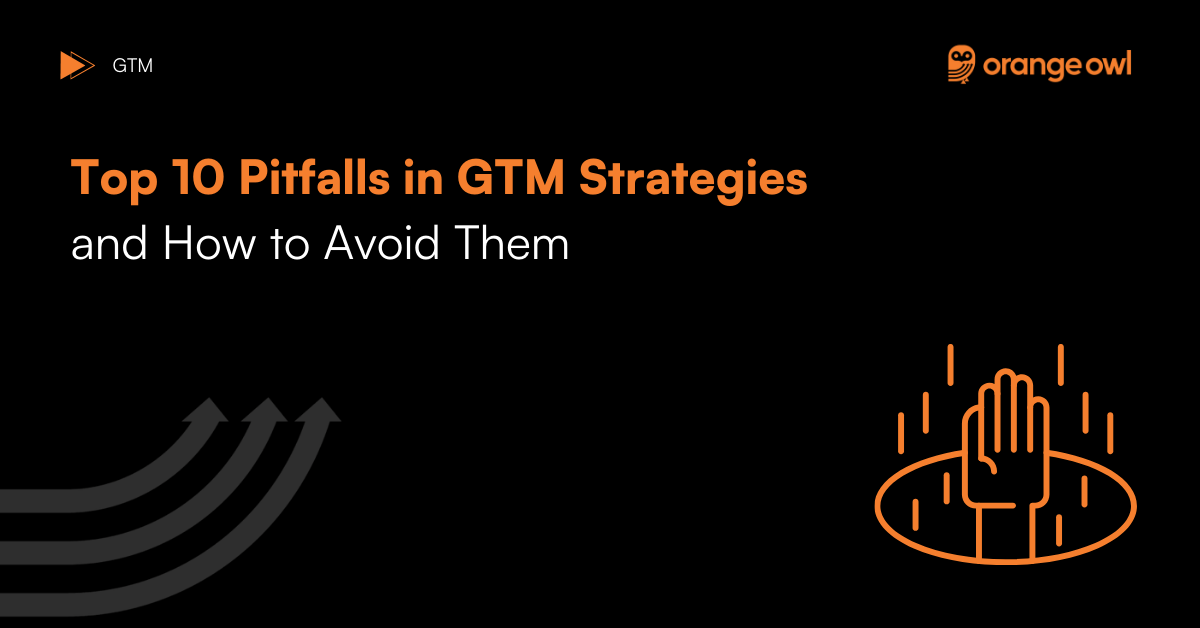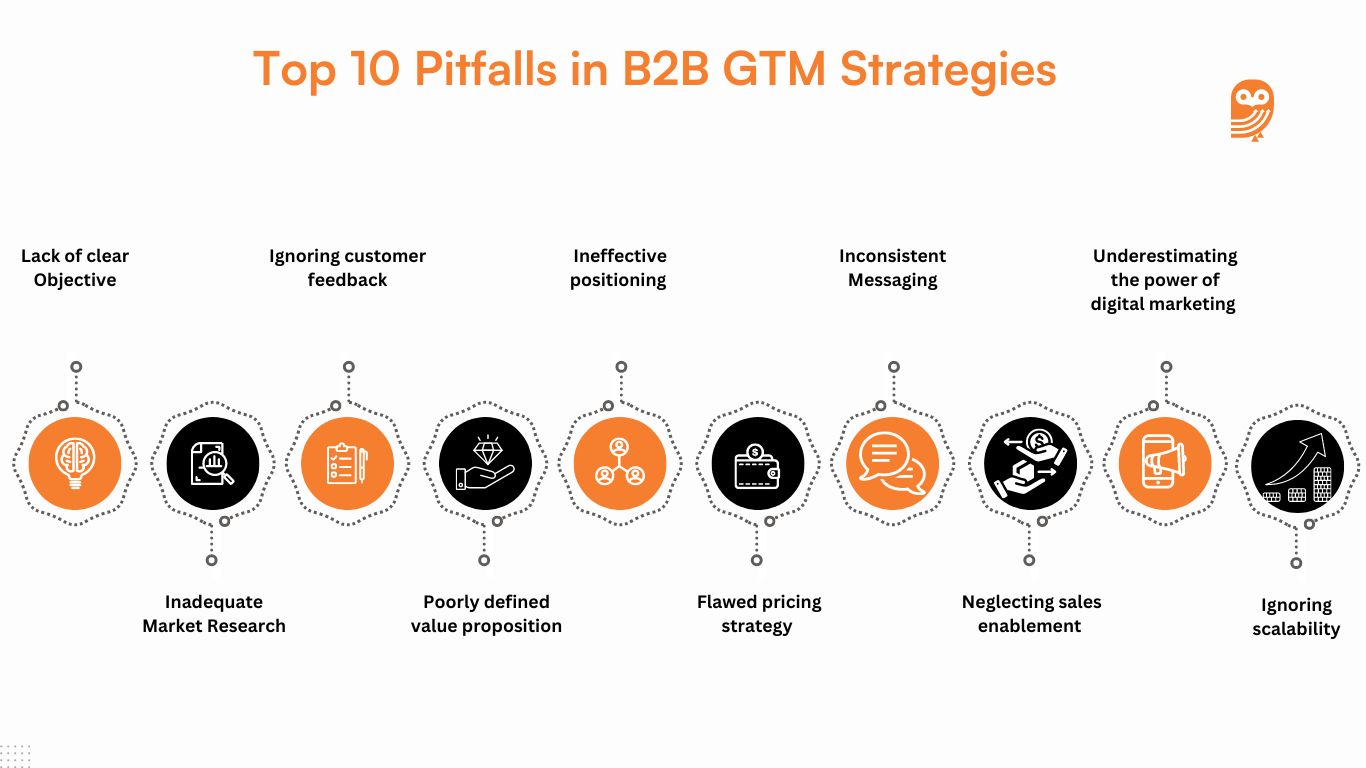Top 10 Pitfalls in B2B GTM Strategies and How to Avoid Them
Vivek Goel
February 1, 2025

Table of Contents
Developing an effective Go-To-Market (GTM) strategy is crucial for B2B companies looking to launch new products or services successfully. However, many fall into common mistakes that can hinder their progress and impact their success.
In this blog, we explore the top ten pitfalls in B2B GTM strategies, with practical examples and tips on how to avoid or correct them.

TOP 10 Pitfalls in B2B GTM Strategies and How to Avoid them
1. Lack of Clear Objectives
Pitfall: Many companies embark on a GTM strategy without clearly defined objectives. This lack of direction can lead to misaligned efforts and wasted resources.
Example: A software company launches a new product without specific goals for market penetration or revenue, resulting in scattered marketing efforts.
Correction: Define specific, measurable, achievable, relevant, and time-bound (SMART) objectives before launching the GTM strategy.
2. Inadequate Market Research
Pitfall: Insufficient market research can lead to a misunderstanding of the target audience, competitors, and market conditions.
Example: A company introduces a cloud storage solution without researching existing competition, leading to an offering that is neither competitive nor innovative.
Correction: Conduct thorough market research, including competitor analysis and potential customer interviews, to tailor your product and marketing efforts.
3. Ignoring Customer Feedback
Pitfall: Companies often overlook the importance of early customer feedback in shaping their GTM strategy.
Example: A B2B service provider ignores initial user complaints about system complexity, resulting in poor adoption rates.
Correction: Implement a feedback loop early in the launch phase to capture and integrate customer insights and improve the product continuously.
4. Poorly Defined Value Proposition
Pitfall: Without a strong value proposition, it’s challenging to differentiate your product from competitors.
Example: A B2B fintech product launches with a focus on features rather than the specific financial benefits it offers, leading to a lukewarm reception.
Correction: Develop a clear value proposition that highlights the unique benefits of your product and directly addresses customer pain points.
5. Ineffective Positioning
Pitfall: Incorrectly positioning your product in the market can alienate potential customers.
Example: A company markets a sophisticated business intelligence tool to small businesses that lack the resources to fully utilize it.
Correction: Position your product based on an understanding of your target customers’ capabilities and needs.
6. Flawed Pricing Strategy
Pitfall: Setting the wrong price for your product can either deter potential buyers or leave money on the table.
Example: A SaaS company sets a price too high without considering the price sensitivity of its target small business market.
Correction: Develop a pricing strategy based on thorough market research and competitor pricing, and consider different pricing tiers.
7. Inconsistent Messaging
Pitfall: Inconsistent branding and messaging can confuse the market and dilute the impact of your GTM strategy.
Example: A company uses different value propositions and messages across various marketing channels, confusing potential customers.
Correction: Ensure all internal teams are aligned and that messaging is consistent across all platforms and materials.
8. Neglecting Sales Enablement
Pitfall: Failure to properly equip sales teams with the tools and information they need can cripple the selling process.
Example: A technology firm launches a product without providing adequate training or sales materials, hindering its sales team’s ability to sell effectively.
Correction: Provide comprehensive sales training, clear sales scripts, FAQs, and updated product information to empower your sales force.
9. Underestimating the Power of Digital Marketing
Pitfall: Many B2B companies fail to leverage digital marketing effectively, missing opportunities to reach a broader audience.
Example: A company relies solely on traditional sales methods and ignores the potential of SEO, content marketing, and social media.
Correction: Integrate digital marketing strategies such as content marketing, SEO, and targeted online advertising into your GTM plan.
10. Ignoring Scalability
Pitfall: Companies often launch a GTM strategy without considering future growth, leading to scalability issues.
Example: A platform is quickly overwhelmed when user numbers exceed expectations, resulting in performance issues and dissatisfied customers.
Correction: Plan for scalability from the start, ensuring that your IT infrastructure and service processes can handle growth.
Bonus Pitfall: Lack of Cross-Functional Collaboration
Pitfall: Siloed departments can lead to disjointed efforts and strategies that do not align.
Example: The product development team’s vision for a new business software does not align with marketing narratives or sales strategies.
Correction: Foster cross-functional teams from the outset of your GTM planning to ensure alignment and unified objectives across departments.
GTM Maturity: A Comparison of B2B Companies
GTM maturity reflects how strategically a company approaches its marketing and sales efforts. Immature companies often rely on short-term, fragmented tactics, while mature companies prioritize consistency, alignment, and a deep understanding of their Ideal Customer Profile (ICP). This difference can significantly impact their ability to generate sustainable growth and revenue.
In the world of B2B companies, the distinction between GTM-mature and GTM-immature organizations lies in their strategic approach. GTM maturity does not depend on a company’s age but rather on their ability to implement thoughtful, consistent, and aligned strategies across their marketing and sales efforts. Below is a comparison of GTM-mature and GTM-immature companies across 10 critical areas.
| GTM Area | GTM-Immature | GTM-Mature |
|---|---|---|
| Goals | Focused on leads, MQLs, SQLs. | Prioritize revenue and sales pipeline velocity. |
| Focus | Short-term campaigns. | Long-term programs. |
| Marketing Planning | – Implementing many tactics quickly. – Switching frequently between tactics. – Trying to be on every channel. – Inconsistent and chaotic activities. | – Excel at 5–7 programs in core buyer channels. – Develop joint marketing and sales playbooks. – Consistent programs. |
| Evaluating Marketing | Last-click attribution. | Blended attribution model using self-attribution, digital analytics, and customer interviews. |
| GTM Strategy | – Lead generation and sales-led motions. – Broad targeting and volume-based campaigns. | – Focus on ICP. – Develop full-funnel marketing programs aligned with the buyer journey. |
| Stack | – Purchase expensive tools without processes. – Prioritize automation. | – Develop processes first. – Start with a lean, inexpensive stack. – Refine and automate selectively. |
| Marketing and Sales Alignment | Siloed teams with different focuses and metrics. One team is often unaware of the other’s activities. | Teams collaborate on marketing and sales programs with revenue as the core metric. Regular pipeline review meetings. |
| Budgeting | Budget allocated only to programs with clear ROI. | Budget spread across brand, demand generation, demand capture, sales enablement, and expansion. |
| Marketing Team | – Broad roles with undefined responsibilities. – Expecting immediate results without direction. | – Start lean. – Build core programs and processes. – Hire specialists to refine programs over time. |
| Growth Path | – Try to solve everything internally. – Treat feedback as criticism. | – Invite specialists to address bottlenecks. – Seek feedback to refine and accelerate growth. |
| Organizational Mindset | Believe buyers can be pushed through the sales process. | Understand the buying process is nonlinear and buyer-driven. Revenue comes from awareness, advocacy, and great products. |
Takeaway
Addressing the GTM pitfalls and putting together a mature GTM is vital for B2B companies aiming to develop a robust and effective GTM strategy. By recognizing and correcting these common errors, businesses can enhance their market entry strategies and achieve sustained success.



